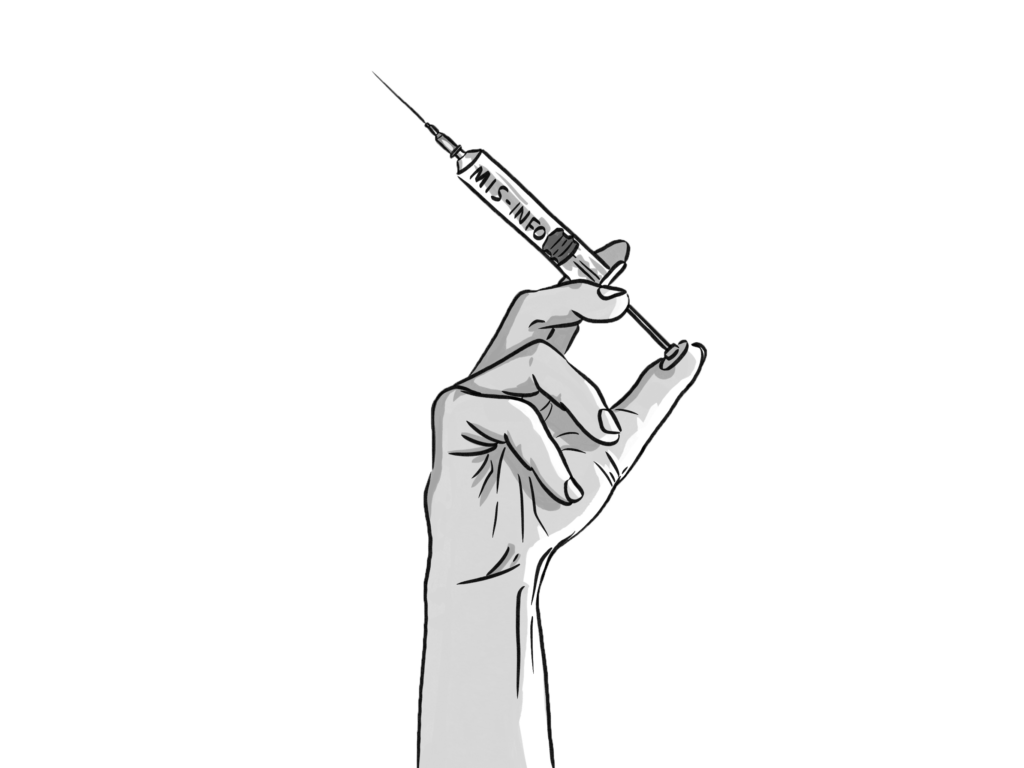As the COVID-19 pandemic ravaged the world in the last three years, many people looked to medical professionals to answer numerous questions. Who does the pandemic affect most? What is my chance of getting COVID-19? And most of all — are vaccines safe, and do they work?
Though there has been an influx of answers available online, many are false. Both disinformation, defined as deliberate hoaxes and lies spread with malicious intent, and misinformation, which is false and inaccurate information, gain traction for a number of reasons, including social media platforms that allow and even promote them.
In some cases, even responses suggested by a medical professional included information that contradicted the messages put out by the Centers for Disease Control and Prevention (CDC).
As a result, the state legislature in California began taking more extreme measures to prevent the deception of citizens by professionals: Bill AB2098 makes misinformation a punishable offense. However, without the proper distinction between misinformation and disinformation, the bill can hinder the ability for doctors to openly discuss different theories without being legally punished, a key process to ensure scientific rigor and accuracy.
History of medical misinformation
Of course, even before the pandemic, medical misinformation was prevalent online, with people turning to both certified and uncertified sources like Healthline, WebMD and medical content creators to diagnose and treat symptoms. While much of the information on these sites is accurate, some is not, and others may easily be misinterpreted by readers.
A recent article by Heathline debunked the myth that eating apricot seeds can cure cancer, for example. Between 1921 and 1974, the dental company Listerine falsely advertised that their mouthwash could cure colds and sore throats, a claim that was also disproven by the Federal Trade Commission in the 1970s.
One of the most publicized cases of medical misinformation is the belief that the vaccine for measles, mumps and rubella (MMR) causes autism, a misleading correlation that has led many individuals to opt out of taking it. In actuality, the signs of childhood autism often appear at the age that the MMR vaccine is administered, and the false correlation makes many parents assume that the events are linked.
This belief is considered to be the catalyst for the “anti-vax” movement, a group who refuses to take immunizations for fear of poisoning themselves, opting for natural treatments instead. The spread of misinformation regarding the MMR vaccine and vaccines in general led to the rallying of a group of people who turned it into a disinformation campaign that continues to affect communities till this day.
A study conducted by Web of Science in March 2018 assessed the spread of misinformation on prevalent social media platforms such as Twitter. It found that false medical information, regardless of the source, was three times more likely to spread than information which was accepted as true.
This phenomenon can be attributed to the right-wing leaning nature of some media algorithms: When a news story is published, it is shown on people’s feeds by auto-generated software that matches content to users’ personality and interests. However, shocking medical discoveries that are often false are spread by humans, who repost it and share it with people they know.
In the rush to publish more medical information during the pandemic, the spread of this misinformation has increased so much that the World Health Organization (WHO) coined a special term for it — the “infodemic,” representing the spread of too much false information.
Misinformation surrounding COVID-19
Following the outbreak of the pandemic, varying and outdated information on major news outlets from healthcare professionals contributed to a loss of public confidence and unity in combating COVID-19, placing lives at risk.
Confusing narratives regarding the spread of COVID-19 also led to a sharp decline in visits to outpatient care facilities as well as hospitals for non-COVID-19 related emergencies.
Due to the endless stream of data and flood of information, people were overwhelmed by the number of opinions and sources. More popular home remedies for COVID-19 emerged, such as the consumption of highly concentrated alcohol-based cleaning products, leading to the deaths of more than 5,800 people who weren’t even hospitalized for the virus in the first place.
Disinformation about vaccines and variants also continued to rise during the pandemic. For example, at one point in USA Today, Ingrid Jacques claimed that wearing a face mask is ineffective in combating the spread of COVID-19, despite the fact that the use of masks were proven effective in several studies and authorized by the CDC.
At the beginning of the pandemic, countless media sources also said that COVID-19 was not any worse than the flu, a claim that was later disproved.
Misinformation can also emerge at the source — scientists — though they may not do it intentionally. Looking for more publicity and acceptance of their work, scientists have been found to unmaliciously present their information more vaguely to the media, which then harps on the gaps and creates their own, shocking narratives around it.
More recently in January, people on social media speculated that NFL safety Damar Hamlin’s cardiac arrest collapse was caused by the COVID-19 vaccine, a blatantly false theory that spread like wildfire within minutes of the incident.
Despite efforts by the WHO — including changing social media policies and guidelines, as well as implementing easier ways of reporting misinformation — to raise public awareness about medical misinformation, it is still unclear to many about specific people and groups they can trust.
Information and knowledge about the pandemic was evolving at such a rapid rate that information online could be outdated as soon as one day after it was published. In March 2021, AstraZeneca, one of the biotech companies in the race for creating a COVID-19 vaccine, was found using outdated data from their clinical trials. Even after the vaccine was approved it caused blood clots and low platelet counts in some patients. Another drug, chloroquine, was approved by the WHO for treating COVID-19, though they quickly retracted its use only three days after its approval.
A constantly changing narrative demanded a concise, unified response, which California rushed to do.
California Bill AB2098 and its halt
In an attempt to combat the spread of contradictory medical information by physicians, California created a law in late 2022 stating that physicians who participate in the dissemination of COVID-19 misinformation could potentially lose their licenses.
According to California governor Gavin Newsom, the bill aims to punish those who act with “malicious intent” and can only be applied to topics about COVID-19. Despite the bill’s efforts to combat these issues, senior U.S. District Judge William Shubb from Sacramento called for an injunction and temporarily blocked its implementation, claiming that it was “too vague for doctors to know what kinds of statements may put them at risk of being penalized.”
His sentiment was echoed by other medical professionals and attorneys, including lawyer Greg Dolin, who is representing a group of doctors arguing against the law. Dolin called the law an attempt to silence doctors whose views aren’t aligned with that of the state government and a violation of the 14th Amendment, which states that “no state shall make or enforce any law which shall abridge the privileges or immunities of the citizens of the United States.”
Other doctors arguing against the law cited the violation of their First Amendment Rights, and pointed to other accountability systems already in place for doctors who spread misinformation directly to their patients. For example, medical boards in Florida and Idaho sanctioned eight physicians for spreading misinformation.
The law fails to distinguish misinformation from disinformation. Allowing doctors to express their personal views of a certain issue allows for the discourse that has continuously ensured scientific rigor.
State and government Action
Though the California bill was created with good intentions, it does not clearly outline what medical professionals can and cannot say. Rather than generalizing the punishment to “all [sources of] misinformation,” the bill could specify that if a medical professional is found saying something that is blatantly accepted as false, they should be punished. However, once someone’s word is passed through countless sources — especially the news — it can be spun in ways against them and be deemed as “against the law” later.
Another, more conservative method of combatting disinformation is to address it at its most likely source — social media and news media. With countless people on the internet spewing their opinions as fact, true medical information becomes hard to find and invalidates the word of medical professionals speaking the truth.
Misinformation during the pandemic resulted from a number of reasons, including the fast progression of COVID-19, quickly-outdated information and an overflow of seemingly reliable sources presenting contradictory information. However, this misinformation quickly became disinformation, two very different entities that the California bill fails to distinguish between. If physicians are unable to distinguish if what they are saying is against the law, a centralized and specific approach needs to be taken in order to enact real change.



























